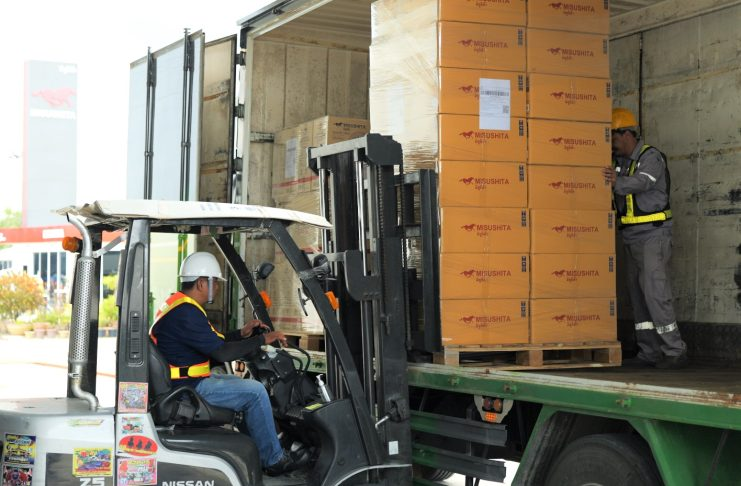Land Transportation Manager (1 years diploma)
Land Transportation Manager click here
Brief Job Description: The individual is responsible for the overall functioning of
the transport hub, people performance, process and systems efficiency to
ensure goods are received and dispatched appropriately and productivity targets
are met. S/he monitors information flows in the hub and develops performance
improvement plan.
Qualifications Pack for Transport Manager
Options:
Option 1: Bid process
The unit is about engaging into bid process management that involves analysing
of tender requirements to decide on bidding and preparing the bid and
documents.

Personal Attributes: The individual should have good leadership skills,
communication skills, analytical skills and professional values. S/he should be
able to lead operations team to solve problems and aid management in decision
making. The role may require working additional hours from time to time and
some physical effort.
Description
Core Skills/Generic
Skills
Core Skills or Generic Skills are a group of skills that are key to learning and
working in today’s world. These skills are typically needed in any work
environment. In the context of the NOS, these include communication related
skills that are applicable to most job roles.
Function
Function is an activity necessary for achieving the key purpose of the sector,
occupation, or area of work, which can be carried out by a person or a group
of persons. Functions are identified through functional analysis and form the
basis of NOS.
Job role Job role defines a unique set of functions that together form a unique
employment opportunity in an organization.
Knowledge and Understanding
Knowledge and Understanding are statements which together specify the
technical, generic, professional and organizational specific knowledge that an
individual needs in order to perform to the required standard.
National Occupational
Standards (NOS) NOS are Occupational Standards which apply uniquely in the Indian context
Occupation Occupation is a set of job roles, which perform similar/related set of functions
in an industry.
Organisational Context
Organisational Context includes the way the organization is structured and
how it operates, including the extent of operative knowledge managers have
of their relevant areas of responsibility.
Performance Criteria Performance Criteria are statements that together specify the standard of
performance required when carrying out a task.
Qualifications
Pack(QP)
Qualifications Pack comprises the set of NOS, together with the educational,
training and other criteria required to perform a job role. A Qualifications
Pack is assigned a unique qualification pack code.
Electives Electives are NOS/set of NOS that are identified by the sector as contributive
to specialization in a job role. There may be multiple electives within a QP for
each specialized job role. Trainees must select at least one elective for the
successful completion of a QP with Electives.
Options Options are NOS/set of NOS that are identified by the sector as additional
skills. There may be multiple options within a QP. It is not mandatory to select
any of the options to complete a QP with Options.
Unit Code Unit code is a unique identifier for an Occupational Standard, which is
denoted by an ‘N’
Unit Title Unit title gives a clear overall statement about what the incumbent should be
able to do.
Qualifications Pack
Code
Qualifications Pack Code is a unique reference code that identifies a
qualifications pack.

Scope
Scope is the set of statements specifying the range of variables that an
individual may have to deal with in carrying out the function which have a
critical impact on the quality of performance required.
Sector Sector is a conglomeration of different business operations having similar
businesses and interests. It may also be defined as a distinct subset of the
economy whose components share similar characteristics and interests.
Sub-Sector Sub-sector is derived from a further breakdown based on the characteristics
and interests of its components.
Sub-functions Sub-functions are sub-activities essential to fulfil the achieving the objectives
of the function.
Technical Knowledge Technical Knowledge is the specific knowledge needed to accomplish specific
designated responsibilities.
Description
3PL Third party logistics
5S Sort, Set In order, Shine, Standardize and Sustain
CAPEX Capital Expenditure
CGST Central Goods and Services Tax
ERP Enterprise Resource Planning
FCL Full Container Load
GPS Global Positioning System
GST Goods and Services Tax
HR Human Resources
HSN Harmonized System Nomenclature
ICD Inland Container Depot
IGST Integrated Goods and Services Tax
IT Information Technology
JIT Just in time
LCL Less than Container Load
MHE Material Handling Equipment
MIS Management information system
MMS Material Management System
NSQF National Skills Qualifications Framework
OH&S Occupational Health and Safety
OPEX Operational Expenditure
OS Occupational Standards
OSHA Occupational Safety and Health Administration
PGA Participative Government Agencies
PO Purchase Order
PPE Personal Protective Equipment
QP Qualifications Pack
RFID Radio-frequency identification
RFP Request for Proposal
SLA Service level agreements
SOP Standard Operating Procedure
TAT Turnaround time
TMS Transport Management System
WMS Warehouse management system
Conduct daily review and facilitate operations
Description This unit is about conducting daily status reviews and facilitating daily operations
Scope This unit/task covers the following:
• Review status of previous day’s work and pending activities
• Approve daily workplans and allocate tasks
• Facilitate smooth operations
• Forecast and budget resources for operations
• Check compliance with legal and regulatory requirements
Range: Computers, Management information system (MIS), Enterprise resource
planning (ERP), performance review softwares, budgeting and forecasting softwares
Performance Criteria(PC) w.r.t. the scope
Element Performance Criteria
Review status of
previous day’s work
and pending
activities
To be competent, the user/individual on the job must be able to:
PC1. review previous day performance reports with supervisors and executives
PC2. plan for completion of pending works
PC3. escalate any situations which needs the input/ intervention of senior
management or client
Approve daily work
plans
and allocate
resources

To be competent, the user/individual on the job must be able to:
PC4. review and approve daily work plan prepared by supervisors, and approve
adhoc resources incase of exingencies
PC5. allocate resources for completion of priority tasks
PC6. prepare/review weekly work plan
Facilitate smooth
operations
To be competent, the user/ individual must be able to:
PC7. monitor and guide subordinates to ensure seamless operations as planned
PC8. ensure optimal utilisation of all assets and resources as per performance
targets
PC9. provide required support in terms of resources, and process clarifications
PC10. facilitate resolution with other departments and external parties in case of
any escalation or deviation
PC11. coordinate with clients in cases of delays, pending issues, etc.
PC12. facilitate training for subordinates on process improvements and develop
their capabilities
PC13. ensure ERP and Information Technology (IT) tools are being used as per
Standard Operating Procedure (SOP)
Forecast and budget
resources for
operations
To be competent, the user/ individual must be able to:
PC14. analyse business trends and forecast business
PC15. prepare budget for resources and assets
PC16. set-up consensus meetings with peers and seniors and get their approval on the forecast and budgets
PC17. prepare weekly and monthly work plans as per budget
Ensure compliance
with legal and
regulatory
requirements
To be competent, the user/ individual must be able to:
PC18. monitor process compliance to relevant state, country and international laws
on a periodic basis
PC19. monitor process compliance to organizational policies and procedures
PC20. review areas of non-compliance and examine the reasons
PC21. take corrective and preventive actions to ensure compliance
PC22. adhere and ensure compliance related to hazardous goods storage and
handling regulations
Knowledge and understanding (K)
A. Organizational
context
(Knowledge of the
company /
organization and
its processes)
The individual on the job needs to know and understand:
KA1. vision, mission and values of the company
KA2. company’s reporting structure to support and expedite project acivities
KA3. company’s policy and work instructions on quality standards as well as
documentation policy
KA4. importance of the individual’s role in the workflow
KA5. company’s policy on business ethics and code of conduct
KA6. business and performance of the company
KA7. knowledge repository and various projects done by the company
KA8. occupational health and safety standards, handling of special and dangerous
goods, etc.
KA9. procedures for dealing with loss or damage to goods
KA10. value of items handled and implications of damage/loss of the same
KA11. risk and impact of not following defined work, safety and security procedures
KA12. company policy defined turnaround time (TATs) and output metrics for daily
operations
KA13. just in time (JIT) mode of inventory management
KA14. coding system followed to label items
KA15. the IT system and ERP system of the organization

B. Technical knowledge
The individual on the job needs to know and understand:
KB1. process flow of service operation and understanding of basic supply chain
value chain
KB2. state/country taxes and routing
KB3. local and global geographies
KB4. use of ERP software including Warehouse management system (WMS),
Transport Management System (TMS) and Material Management System
(MMS)
KB5. use tools for documentation: MS excel and MS Word, etc.
KB6. basics of statistical and quantitative analysis tools
KB7. use of spreadsheets to tabulate and analyze the data
KB8. structure and implications of fees and charges involved in transportation,
warehousing, processing clearances, etc.
KB9. transit rules and regulations
KB10. different Material Handling Equipment (MHEs) and other equipment used for
handling the shipment
KB11. procurement related concepts like Purchase order (PO), Invoices, procedures
etc.
Skills (S)
A. Core skills/
generic skills
Reading skills
The user/individual on the job needs to know how to read:
SA1. work instructions, customer requirement and quality policy
SA2. legal policies and regulations
SA3. internal communications memorandums
SA4. checklists and daily reports
Writing skills
The user/individual on the job needs to know how to:
SA5. maintain the record of as per company’s policy
SA6. make the note of instructions to team members
SA7. develop operating procedures and their updation
SA8. write communications, letters both within the company and to other
stakeholders and clients
SA9. prepare daily reports, checklists and create documents for internal
communication
Oral communication (listening and speaking skills)
The user/individual on the job needs to know how to:
SA10. communicate with all internal and external stakeholders
SA11. share experiences and provide guidance to juniors and peers
SA12. listen to queiries and requirements of internal and external stakeholders

B. Professional skills Decision making
The user/individual on the job needs to know how to:
SB1. decide regarding allocation of adequate resource based on forecasts and job
requirement
SB2. decide on appropriate ways to resolve inefficiency, escalations, pilferage
issues, etc.
SB3. priortise the work flow based on review of the variuous reports and urgent
requirements
Plan and organize
The user/individual on the job needs to know how to:
SB4. prioritize and execute the work order within pre-decided timelines
SB5. maintain schedules and punctuality for work process
SB6. plan and forecast for upcoming events, festivals which may create high
demand or high absenteeism of human resources
SB7. motivate team members to achieve the targets
Customer centricity
The user/individual on the job needs to know how to:
SB8. adhere to the customer timelines
SB9. prevent company and customer information leakage
SB10. address the requirement of the customer
SB11. take prompt action on queries raised by the customer
SB12. plan for any alternatives in case of delays
SB13. maintain regular contact with customer and keep him/her updated on status
Problem solving
The user/individual on the job needs to know how to:
SB14. identify trends/common causes for errors and suggest possible solutions
SB15. identify departments and areas of inefficiencies
SB16. handle day to day escalated problems like delays, staffing shortage, external
factors, etc
SB17. delegate work appropriately
SB18. identify and resolve issues due to technical or human error
Analytical thinking
The user/individual on the job needs to know and understand how to:
SB19. analyze the resource requirement in terms of manpower, delivery vehicles,
software, system, etc. in line with forecasts and past trends
SB20. provide suggestions and methodologies for operational activities in order to
increase the productivity
SB21. analyse reports and take necessary action
SB22. assess delays or non-performance in daily reporting or closures
SB23. anticipate external factors that may affect operations and plan for the same
Critical Thinking
The user/individual on the job needs to have ability to:
SB24. think through on different queries and escalations and quickly identify
possible solutions and work-around
SB25. handle personality clashes
SB26. think tactically to handle adverse situations, with attention to details
SB27. improve work processes by adopting global best practices
Business development and stakeholder relations
Description This unit is about generating new business and maintaining relation with all
stakeholders
Scope This unit/task covers the following:
• Generate new business prospects
• Maintain customer relations
• Coordinate with government officials, vendors and contractors
Range: Computers, Enterprise resource planning (ERP), business lead softwares
Performance Criteria(PC) w.r.t. the scope
Element Performance Criteria
Generate new
business prospects
To be competent, the user/individual on the job must be able to:
PC1. obtain list of existing clients and new prospects from the company’s sales
database.
PC2. prepare sales targets and relationship strategies
PC3. prioritize the clients for contacting, based on the previous relationship
building calls made to each of them
PC4. call clients and prospects to seek meeting

PC5. meet client to offer new services and take feedback for current services
PC6. identify client’s business need and offer customized and bundled solutions
PC7. negotiate on costs, close the deal and collect organizational and payment
details of the client
PC8. take client’s feedback
PC9. update information into ERP, inform the relevant departments on sale
closure
Maintain customer
relations
To be competent, the user/ individual must be able to:
PC10. regularly interact with the client over phone, emails or personal visits and
quickly respond to their queries
PC11. address the query raised by the customers effectively and timely
PC12. take appropriate actions on escalations raised by customers
PC13. handle customer grievances such as damage or tampering of shipment,
extra charges levied, failure to deliver as per commitment, delays etc.
PC14. provide regular information to clients regarding new offerings, discounts,
customised solutions, etc.
Co-ordinate with
government officials,
vendors and
contractors
To be competent, the user/ individual must be able to:
PC15. liaise with customs, Partner Government Agencies (PGAs), other Govt.
departments, etc. and build professional relations with them
PC16. analyse and manage insurance claim requests
PC17. co-ordinate with marketing agencies for publicity of services of the company
PC18. negotiate with carriers, warehouse and transport operators, custom
brokers, insurance company representatives, vendors, etc. for services,
preferential rates, service level agreements (SLA), payment period, etc.
PC19. co-ordinate with labour contractor and local vendors for sufficient
workforce, carrier vehicle availability as per work demand
Knowledge and understanding (K)
A. Organizational
context
(Knowledge of the
company /
organization and
its proses)
The individual on the job needs to know and understand:
KA1. vision, mission and values of the company
KA2. company’s reporting structure to support and expedite project acivities
KA3. company’s policy and work instructions on quality standards as well as
documentation policy
KA4. importance of the individual’s role in the workflow
KA5. company’s policy on business ethics and code of conduct
KA6. business and performance of the company
KA7. knowledge repository and various projects done by the company
KA8. occupational health and safety standards, handling of special and dangerous
goods, etc.
KA9. procedures for dealing with loss or damage to goods
KA10. value of items handled and implications of damage/loss of the same
KA11. risk and impact of not following defined work, safety and security procedures
KA12. company policy defined Turnaround time (TATs) and output metrics for daily
operations
KA13. just in time (JIT) mode of inventory management
KA14. coding system followed to label items
KA15. the Information Technology (IT) system and ERP system of the organization
B. Technical knowledge
The user/individual on the job needs to know and understand:
KB1. process flow of service operation, value chain and basic supply chain value
map within the sub sector
KB2. state/country taxes and routing
KB3. local and global geographical knowledge
KB4. use of ERP software including Warehouse management system (WMS),
Material Management System (MMS) and Transport Management System
(TMS)
KB5. use of tools for documentation: MS excel and MS Word, etc.
KB6. basics of statistical and quantitative analysis tools
KB7. use of spreadsheets to tabulate and analyze the data
KB8. structure and implications of fees and charges involved in transportation,
warehousing, etc.
KB9. transit rules and regulations
KB10. significance of team coordination to achieve revenue and productivity targets
of the organisation
KB11. customer relationship management
KB12. about contract management and SLA
KB13. factors for evaluation of performance of vendors
Skills (S)
A. Core skills/ generic
skills
Reading skills
The user/ individual on the job needs to know how to read:
SA1. company quality policy, work instructions and customer requirement
SA2. transit rules and trade policies

SA3. regulatory requirement associated with custom clearance
SA4. e-mails, invoices, letters, notes, memos, agreement reports, etc.
Writing skills
The user/ individual on the job needs to know how to:
SA5. write e-mails and letters to government officials, customers, vendors, etc.
SA6. note information about vendors on factors like quality of service,on-time
order completion, cooperation etc
Oral communication (listening and speaking skills)
The user/ individual on the job needs to know how to:
SA7. listen and understand the requirements of the client
SA8. communicate with clients, government officials and other external
stakeholders by using various communication channels
SA9. exchange information with other managers, supervisory and operational staff
at all levels
SA10. carefully listen to vendor concerns and issues
B. Professional skills Decision making
The user/ individual on the job needs to know how to:
SB1. decide corrective measures to improve customer ratings
SB2. decide actions to be taken on escalations raised by the customer
SB3. decide appropriate action for poor performance and lack of cooperation by
vendor/ Third party logistics (3PL)
SB4. identify and prioritise on select clients and prospects for generating business
Plan and organize
The user/ individual on the job needs to know how to:
SB5. liaison with customers, government officials, vendors and staff to ensure that
smooth functioning of service centre/office
SB6. plan and organise review meetings with vendors, contractors
SB7. organise projects/ training plans for performance improvement
Customer centricity
The user/ individual on the job needs to know how to:
SB8. take prompt action on queries raised by the customer
SB9. address customer requirement and offer customized or bundled solutions
SB10. suggest ideas and solutions to increase customer loyalty and satisfaction
Problem solving
The user/ individual on the job needs to know how to:
SB11. resolve the queries raised by customers as well as government officials
SB12. address the queries raised by vendors, contractors and other external stakeholders
Analytical thinking
The user/ individual on the job needs to know and how to:
SB13. identify the factors that helped improve customer satisfaction
SB14. identify commonly preferred bundles and customisations
SB15. analyse reasons for customer dis-satisfaction
SB16. identify areas that are crucial for performance improvement
Critical thinking
The user/ individual on the job needs to know how to:
SB17. improve work processes by adopting best practices
SB18. act upon constructively on any problems as identified
SB19. handle personality clashes effectively
Review performance and develop performance improvement plan
Description This unit is about reviewing performance of activities and processes, root cause
analysis for deviations, and implementing performance improvement plan
Scope This unit/task covers the following:
• Analyse activity wise operational performance
• Identify reasons for non-performance and areas for improvement
• Implement performance improvement action plans
• Provide leadership and direction
Range: Standard Operating Procedures (SOP), Management information system (MIS),
Enterprise Resource Planning (ERP), worksheets, stationery, computer, projector etc.
Performance Criteria(PC) w.r.t. the Scope
Element Performance Criteria
Analyse activity wise
operational
performance
To be competent, the user/ individual must be able to:
PC1. analyse activity related performance metrics
PC2. review output reports for escalated cases to identify reasons
PC3. review asset utilization rates and revenue per manpower
PC4. analyse trend of defaults, delays, etc. along with their reasoning
PC5. analyse the trends of various output metrics like average time per case,
average number delays per week, etc. to measure operational performance
Identify reasons for non-performance and areas of improvement
To be competent, the user/ individual must be able to:
PC6. analyse reasons for non-performance with respect to each operation and
department
PC7. identify process improvement areas and departments
PC8. identify training needs and develop training plans
PC9. analyse resource utilization trends to arrive at cases of under-utilization and
poor equipment management
PC10. examine staff turnover issues
PC11. identify the department and staffs that are underperforming and take
necessary actions to improve performance
Implement
performance review
action plan
To be competent, the user/ individual must be able to:
PC12. prioritise performance improvement project implementation
PC13. develop strategic action plans to increase overall worker and operational
efficiency
PC14. communicate performance improvement benefits to senior management and
take their approval
PC15. establish key performance indicators, track regular performance output with
respect to set goals and take corrective actions
PC16. address all employee performance problems promptly and directly in accordance with personnel policies
PC17. take necessary action in case of theft or fiddling with the shipment
Provide leadership
and direction
To be competent, the user/ individual must be able to:
PC18. develop, implement, and manage departmental policies, procedures,
standards and strategies as required
PC19. set objectives and provide support to team members
PC20. communicate and emphasise on policies and standards in line with the
regulations laid down by various governing Acts
PC21. guide and support them to cope with work load
PC22. conduct meetings with staff to assess group’s overall performance; discuss
ideas for improvement and inform staff of new developments
PC23. support team members in identifying, developing and implementing new
ideas
PC24. direct the hiring, training, and performance evaluations of staff
Knowledge and understanding (K)
A. Organizational
context
(Knowledge of the
company /
organization and
its processes)
The user/individual on the job needs to know and understand:
KA1. vision, mission and values of the company
KA2. company’s policy on business ethics and code of conduct
KA3. business and performance of the company
KA4. knowledge repository and various projects done by the company
KA5. reporting structure to support and expedite project acivities
KA6. escalation matrix for reporting issues/challenges
KA7. company’s policy and work instructions on quality standards
KA8. company’s personnel management and incentives rules
KA9. importance of the individual’s role in the workflow
KA10. company policy defined turnaroung time (TATs) and output metrics for daily
operations
KA11. company’s approach towards skill up-gradation and technology modernisation
KA12. company’s training plans and schedules
B. Technical
Knowledge
The user/individual on the job needs to know and understand:
KB1. process flow of service operation, value chain and basic supply chain map
within the sub sector
KB2. state/country taxes and routing
KB3. local and global geographical knowledge
KB4. use of ERP software including Warehouse management system (WMS),
Material Management System (MMS) and Transport Management System
(TMS)
KB5. use of various tools for documentation: MS excel and MS Word, etc.
KB6. basics of statistical and quantitative analysis tools
KB7. use of spreadsheets to tabulate and analyze the data
KB8. structure and implications of fees and charges involved in transportation,
warehousing, etc.
KB9. transit rules and regulations
KB10. significance of team coordination to achieve revenue and productivity targets
of the organisation
KB11. customer relationship management and contract management, and Service
level agreements (SLA)
KB12. factors for evaluation of operational performance and utilization for
resources
KB13. different metrics of performance evaluation
KB14. different solutions to improve performance and utilization
Skills (S)
A. Core skills/
generic skills
Reading skills
The user/ individual on the job needs to know how to read:
SA1. company policy and standard work related documents
SA2. emails, letters and instructions
SA3. daily reports
Writing skills
The user/ individual on the job needs to know how to:
SA4. prepare reports on delivery performance, demand forecast, franchisee
performance etc.
SA5. write Minutes of Meeting, mails and memos
Oral communication (listening and speaking skills)
The user/ individual on the job needs to know how to:
SA6. interact with team members to work efficiently
SA7. communicate effectively with colleagues and vendors to achieve smooth
workflow
SA8. communicate quality standards and performance metrics clearly to all the
employees
SA9. listen to queries patiently and answer them aptly
B. Professional skills Decision making
The user/ individual on the job needs to know how to:
SB1. decide on corrective measures to improve performance
SB2. identify and prioritise modules of improvement plans
SB3. prioritise areas for performance improvement
SB4. decide on actions to be taken on any issues identified hampering operational
efficiency
SB5. identify departments providing high performance and departments with low
performance
SB6. decide on training plans and improvement plans for departments and
individuals
Plan and organize
The user/ individual on the job needs to know how to:
SB7. plan and organise performance review sessions
SB8. make action plan for performance improvement
SB9. organise projects/ training plans for performance improvement
SB10. monitor the activities of the performance improvement plan
SB11. plan and organise monitoring activities to ensure no breach in terms of
commitments
SB12. timely complete analysis on reports and issues identified
Customer centricity
The user/ individual on the job needs to know how to:
SB13. analyse performance with focus on customer requirement and ability to
improve satisfaction levels with customers
SB14. sensitise individuals towards customer satisfaction and train them accordingly
Problem solving
The user/ individual on the job needs to know how to:
SB15. resolve interpersonal issues among employees
SB16. resolve performance related bottlenecks with respect to individuals and
resources
SB17. guide staff towards appropriate training to improve performance and remove
bottlenecks
SB18. assess resource utilization and performance and suggest solutions to remove
bottlenecks
Analytical thinking
The user/ individual on the job needs to know and understand how to:
SB19. analyse reports and take necessary action
SB20. analyse output and delivery performance to infer bottlenecks
SB21. assess the performance of resources to see capacity utilization
SB22. assess performance to see if there is a need for technology up-gradation or
training
Critical thinking
The user/ individual on the job needs to know and understand how to:
SB23. improve work processes by adopting global best practices
SB24. resolve recurring inter-personal or system related conflicts with colleagues
that hinder service
SB25. act upon constructively on any problems as pointed by seniors
SB26. review performance with respect to requirement and compare with global
peers to see prospects for technology and skill up-gradation







